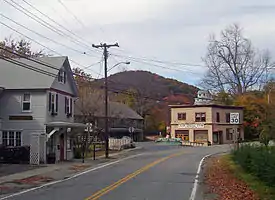Wassaic, New York | |
|---|---|
Hamlet and CDP | |
 Downtown Wassaic | |
 Wassaic Location in New York state | |
| Coordinates: 41°48′14″N 73°33′31″W / 41.8039825°N 73.5587368°W | |
| Country | |
| State | |
| County | Dutchess |
| Town | Amenia |
| Elevation | 139 m (456 ft) |
| Population | |
| • Total | 210 |
| Time zone | UTC−5 (Eastern (EST)) |
| • Summer (DST) | UTC−4 (EDT) |
| ZIP Code | 12592 |
| Area code | 845 |
| GNIS feature ID | 968879[1] |
Wassaic is a hamlet and census-designated place[2] in the town of Amenia, Dutchess County, New York, United States. As of the 2020 census, its population in 210.[3] Located in southeastern New York in the valley of the Ten Mile River, Wassaic is bordered to the east and west by mountain ranges.
The name of the hamlet is derived from the Native American word Washaic; "land of difficult access" or "narrow valley". However, Europeans found ready access by following the Housatonic River valley up from Long Island Sound and through the mountains along the Ten Mile River.
One of the earliest recorded Europeans to settle in Wassaic was Richard Sackett. He petitioned the Colonial Government on March 11, 1703[4] for a license to purchase a tract of land in "Washiack". He was known as Captain Richard Sackett when appointed the first Dutchess County clerk in 1715.[4]
By the 1770s, Wassaic was processing Ancram pig iron into steel. This continued into the early 1800s, providing steel for the Harris scythe works at Hammertown, near Pine Plains in northern Dutchess.
During the Revolutionary War, General George Washington marched through Wassaic on the way to Connecticut.
Among Wassaic's main employers in the 19th century were Gridley Iron Works[5] and the Harlem division of the New York and Harlem Railroad. In 1861, Gail Borden opened a factory for producing a condensed milk that would not need refrigeration. This was a welcome ration for the Union troops during the Civil War. Long sold by Borden, it is today marketed as Eagle Brand Condensed Milk. Wassaic was also known for dairy, sheep and grain farming.
Wassaic is home to The Wassaic Project, a non-profit arts and music organization and the Wassaic Artist Residency. They provide summer programming as well as run an artist in residence program.
Demographics
| Census | Pop. | Note | %± |
|---|---|---|---|
| 2020 | 210 | — | |
| U.S. Decennial Census[6] | |||
Transportation
Wassaic station is the northernmost station on the Harlem Line of Metro-North Railroad. The station, once located in the hamlet, has been moved one mile north of it. The station also provides easy access to the Harlem Valley Rail Trail, which extends south to the Hamlet of Wassaic and north, for approximately 24 miles, to Orphan Farm Road, above Taconic State Park. The trail follows the former route of the Harlem Division of the New York and Harlem Railroad, and is used for recreational hiking and biking.
References
- ↑ U.S. Geological Survey Geographic Names Information System: Wassaic, New York
- ↑ "State of New York Census Designated Places - Current/BAS20 - Data as of January 1, 2019". tigerweb.geo.census.gov. Archived from the original on February 24, 2020. Retrieved February 24, 2020.
- ↑ U.S. Census Bureau, 2020 census results, Wassaic CDP, New York. https://www.census.gov/search-results.https://www.census.gov/search-results.html?searchType=web&cssp=SERP&q=Wassaic%20CDP,%20New%20York
- 1 2 "The history of Dutchess County, New York". 1909.
- ↑ Ghee, Joyce (1998). Harlem Valley Pathways. Arcadia Publishing. p. 57. ISBN 978-0738589831.
- ↑ U.S. Census Bureau, 2020 census results, Wassaic CDP, New York. https://www.census.gov/search-results.https://www.census.gov/search-results.html?searchType=web&cssp=SERP&q=Wassaic%20CDP,%20New%20York
External links
![]() Media related to Wassaic, New York at Wikimedia Commons
Media related to Wassaic, New York at Wikimedia Commons
